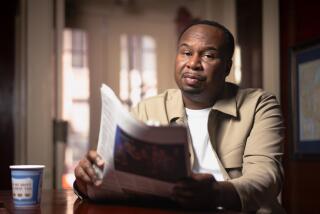Seeds Were Planted Early for Marriage of News, Entertainment
- Share via
In the 1950s, when John Daly was the anchor of ABC’s nightly news, he was also the moderator of the quiz show “What’s My Line?” From 1957 to 1961, Douglas Edwards, then the anchor of CBS’ nightly news, was also the host of “Armstrong Circle Theatre,” which presented many dramas based on real-life events. One might call them docudramas or re-enactments.
A sort of unholy alliance between news and entertainment has touched, and often tainted, television programming almost from the medium’s birth.
Thus, there is a curious sort of honesty--or at least logic--in the fact that two major Hollywood entertainment studios, 20th Century Fox and Disney, now are openly taking a direct hand in creating and presenting nightly news programming for several of Los Angeles’ major television stations.
The Fox television network owns KTTV-TV Channel 11. And the personal involvement of Fox president Barry Diller in the news operation is widely known. Disney, meanwhile, has bought its first station, KHJ-TV Channel 9. And KHJ’s top executives acknowledge that Disney chairman Michael Eisner is being consulted about the development of the station’s upcoming, nightly 3-hour newscast.
Given network TV’s pratfalls over the current controversy in news--the re-enactments on CBS’ “Saturday Night With Connie Chung” and NBC’s “Yesterday, Today & Tomorrow”--there may well be less befuddlement and hypocrisy in what the entertainment guys at the studios serve up. There are no legacies of Edward R. Murrow and Eric Sevareid to haunt Fox and Disney.
At KTTV, it’s all above board, with no apologies or public guilt trips. You want tabloid shows? You got ‘em: “A Current Affair,” “America’s Most Wanted,” “Totally Hidden Video.” But the local KTTV news operation is no flashier than that of other Los Angeles stations. After all, it’s at KABC-TV Channel 7 that anchors Paul Moyer and Ann Martin are roped into answering Todd Donoho’s inane sports trivia questions.
KHJ, meanwhile, is promising a real whiz-bang news operation when its nightly 3-hour coverage, scheduled to begin March 5, gets rolling, with Jerry Dunphy heading a staff of 140-plus. No way, says KHJ, that its news will be overly oriented toward entertainment just because Disney owns it. Well, we’ll see. However, Disney, smart and secure, probably knows that a good newscast is showmanship enough.
But while Fox and Disney seem reasonably focused in their news plans, the networks--which have a lot more experience in the field--are going through another crisis of conscience in the TV twilight zone where journalism and entertainment meet.
You’d think the networks could handle the problem by now. After all, this is a business where a chimpanzee named J. Fred Muggs helped make a hit back in 1953 of the fledgling “Today” show, which became the pride, if not always the joy, of NBC News.
But the truth is, the networks, and all of TV, were shaken up more than they may know by a show that debuted a decade ago, in April 1979. It was called “Real People,” and it changed the course of TV programming by altering the public’s perception of what news is and how it should be presented. It’s likely that no one connected with the show realized this would happen, but it did.
“Real People,” which ran for five years on NBC, presented human-interest stories that might well have been candidates for traditional news programs. But it presented them in a looser, entertainment-style format, and the hosts were, for the most part, celebrities and performers rather than formal news figures.
Does the format sound familiar? Do you feel you’re drowning in a flood of such shows on the airwaves today?
The hosts of “Real People” ranged from the witty John Barbour to more mundane talents like Sarah Purcell and Skip Stephenson. And, by and large, they gave the impression that you might get a hug from them or a friendly slap on the shoulder if you were the subject of one of their stories. No distant, Olympian, unapproachable figures here like a Cronkite or a Jennings or a Chancellor. The seeds of future TV reality shows were planted.
“Real People” was a hit, and it spawned imitators like “That’s Incredible!” Some network news executives were uncomfortable with “Real People” treading on ground close to their terrain. And at NBC, they finally reacted with wrath when a follow-up series, “Speak Up, America,” debuted in 1980, again dealing with topical subjects from the news area, this time with former child evangelist Marjoe Gortner as a host, along with Jayne Kennedy and Rhonda Bates.
“Speak Up, America,” despised by critics who branded it “Shut Up, America,” was gone in a little over two months. But the “Real People” syndrome was here to stay as an unending burst of featherweight newsmagazines hit the airwaves, hosted by fatuous celebrities with little or no news experience. What’s more, the “Real People” approach was adopted with a vengeance by local TV news programs around the nation--just tune in your friendly, joking, neighborhood anchor-buddy any day for the ongoing proof.
No surprise, then, that TV’s Siamese twins--news and entertainment--remain painfully joined to this very day. No surprise that NBC announced that it will switch “Yesterday, Today & Tomorrow” from its news department to its entertainment division in a meaningless move; the re-enactments will remain. No surprise that NBC Entertainment president Brandon Tartikoff chairs a network policy committee on which the head of the news division, Michael Gartner, is simply a member.
No surprise, either, that Richard Nixon, in a brilliantly cynical observation, told TV Guide: “TV is an entertainment medium, not an educational one. The combative, even obnoxious, personalities are the most successful. The superficial, the colorful and the offbeat are far more likely to make the evening news than dry policy reports.”
And no surprise that CNN and C-SPAN are replacing the networks as the TV news sources for serious viewers.
More to Read
The biggest entertainment stories
Get our big stories about Hollywood, film, television, music, arts, culture and more right in your inbox as soon as they publish.
You may occasionally receive promotional content from the Los Angeles Times.










